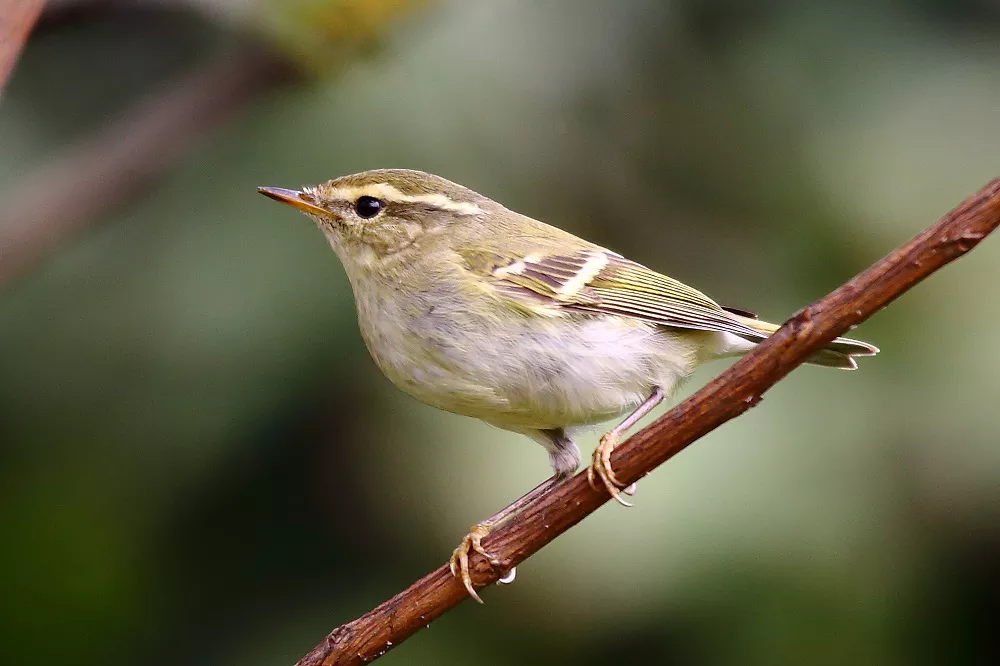The yellow-browed warbler (Phylloscopus inornatus) is a leaf warbler (family Phylloscopidae). A small, slender insectivorous bird with a pointed beak. Length: 9-12 cm, Weight: 6-9 g. It mainly inhabits forests in plateaus, mountains and plains at an altitude of several meters to 4000 meters.
What does a Yellow-browed warbler look like
The yellow-browed warbler is olive-green above; eyebrows are light yellow-green; wings have two light yellow-green wing spots; underparts are white with greenish-yellow. The upper body, including the inner coverts of the two wings, is olive green, and the head is darker, with a looming yellow-green longitudinal stripe running through the center of the head. Eyebrow lines yellowish green. There is a dark brown longitudinal stripe starting from the eye, passing through the eye and reaching the occipital; the rest of the head is yellow and greenish brown mixed; the wing coverts and flight feathers are dark brown; And except for the outermost flight feathers, the rest of the feathers are decorated with white; the tips of the large and middle coverts are light yellow and white, forming two wing spots on the wings; the tail feathers are dark brown, and the outer edge of each wing is olive green. The color is narrow, and the inner edge is white. The underparts are white, and the chest, flanks, and undertail coverts are slightly greenish-yellow, as are the axillary feathers. The plumage of both sexes is similar.
Iris dark brown; corners of mouth black, lower mouth base light yellow; tarsus light brown.
Yellow-browed warbler habitat
It inhabits forests on plateaus, mountains and plains at an altitude of several meters to 4000 meters, including coniferous forests, mixed coniferous and broad-leaved forests, willow thickets and forest edge shrubs, as well as gardens, orchards, fields, villages, courtyards, etc.
Yellow-browed warbler living habit
- Behavior
Yellow-browed warblers often move alone or in groups of three or five. It is rare to see them in large groups, but large groups can be seen during migration. Due to their small size and green color, they are usually difficult to spot unless they hear a call or fly short distances from one tree to another. It rarely lands, and the peak of activity is in the morning and evening. Forages on aphids and small insects on various trees, especially on trees near water. Chang Fei landed at the bottom of the tree, and jumped up again, almost never stopping, looking for food on the tree with light, flexible and agile movements. If it is not disturbed, it can stay among the branches for a long time, jumping up and down without stopping, busy looking for food. Due to its light body, it can even peck insects on leaves on twigs and petioles. When catching insects that are too large to be swallowed, they often hold the insects in their mouths and smash them on the tree before swallowing them. It flies fast. When looking for food, it only flies from tree to tree, and when it leaves, it flies high. This bird has a special dynamic. It often swings its body left and right with its two feet as the center on the tree, constantly changing the angle of the body, in order to find food in a wider range of vision.
- Sound
Yellow-browed warbler has two kinds of calls: one is crisp and soft, usually single “ju”, three “ju-ju-yi” or four “ju-ju-yi-zhi”. The monophonic “ju-” when disturbed is often heard alone, frightened, and in the rain. When two or three birds are looking for food together on a tree, when they fly from a perching branch to another branch or another tree, they will make a four-time chirp of “ju-jue-yi-zhi”, which has the function of calling. There are insects on the tree, and when they are searching for food, they make “ju-jue-yi-zhi” four times at a time along with the body swing. The first pendulum is called “ju”, the second pendulum is called “jue-yi”, and the third pendulum is called “zhi”, which is the sound caused by food. When it is cloudy or rainy, it is heard from time to time due to frequent foraging activities. The other is the high-pitched chirping, which is very pleasant to the ear.
- Food
Mainly feed on insects, no fly catch. It feeds on small insects between the branches and leaves of trees. 99.12% is animal food, of which insects account for 97.4%, and Coleoptera insects are the most. There are mainly pests such as scarab beetles, leaf beetles, and beetles, followed by Lepidoptera insects. In addition, there are insects such as stinkbugs, night jumping cicadas, ants, mosquitoes, bees and other insects and spiders.
A common species in most of its wide range, the yellow-browed warbler is not considered threatened by the IUCN.


 Facebook
Facebook  Instagram
Instagram  Youtube
Youtube 